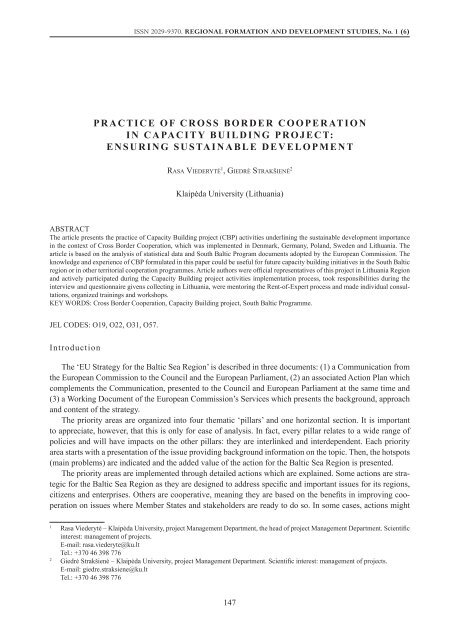Regional Formation 2012,1 - KlaipÄdos universitetas
Regional Formation 2012,1 - KlaipÄdos universitetas
Regional Formation 2012,1 - KlaipÄdos universitetas
You also want an ePaper? Increase the reach of your titles
YUMPU automatically turns print PDFs into web optimized ePapers that Google loves.
ISSN 2029-9370. <strong>Regional</strong> <strong>Formation</strong> and Development Studies, No. 1 (6)<br />
PRACTICE OF CROSS BORDER COOPERATION<br />
IN CAPACITY BUILDING PROJECT:<br />
ENSURING SUSTAINABLE DEVELOPMENT<br />
Rasa Viederytė 1 , Giedrė Strakšienė 2<br />
Klaipėda University (Lithuania)<br />
Abstract<br />
The article presents the practice of Capacity Building project (CBP) activities underlining the sustainable development importance<br />
in the context of Cross Border Cooperation, which was implemented in Denmark, Germany, Poland, Sweden and Lithuania. The<br />
article is based on the analysis of statistical data and South Baltic Program documents adopted by the European Commission. The<br />
knowledge and experience of CBP formulated in this paper could be useful for future capacity building initiatives in the South Baltic<br />
region or in other territorial cooperation programmes. Article authors were official representatives of this project in Lithuania Region<br />
and actively participated during the Capacity Building project activities implementation process, took responsibilities during the<br />
interview and questionnaire givens collecting in Lithuania, were mentoring the Rent-of-Expert process and made individual consultations,<br />
organized trainings and workshops.<br />
KEY WORDS: Cross Border Cooperation, Capacity Building project, South Baltic Programme.<br />
JEL codes: O19, O22, O31, O57.<br />
Introduction<br />
The ‘EU Strategy for the Baltic Sea Region’ is described in three documents: (1) a Communication from<br />
the European Commission to the Council and the European Parliament, (2) an associated Action Plan which<br />
complements the Communication, presented to the Council and European Parliament at the same time and<br />
(3) a Working Document of the European Commission’s Services which presents the background, approach<br />
and content of the strategy.<br />
The priority areas are organized into four thematic ‘pillars’ and one horizontal section. It is important<br />
to appreciate, however, that this is only for ease of analysis. In fact, every pillar relates to a wide range of<br />
policies and will have impacts on the other pillars: they are interlinked and interdependent. Each priority<br />
area starts with a presentation of the issue providing background information on the topic. Then, the hotspots<br />
(main problems) are indicated and the added value of the action for the Baltic Sea Region is presented.<br />
The priority areas are implemented through detailed actions which are explained. Some actions are strategic<br />
for the Baltic Sea Region as they are designed to address specific and important issues for its regions,<br />
citizens and enterprises. Others are cooperative, meaning they are based on the benefits in improving cooperation<br />
on issues where Member States and stakeholders are ready to do so. In some cases, actions might<br />
1<br />
Rasa Viederytė – Klaipėda University, project Management Department, the head of project Management Department. Scientific<br />
interest: management of projects.<br />
E-mail: rasa.viederyte@ku.lt<br />
Tel.: +370 46 398 776<br />
2<br />
Giedrė Strakšienė – Klaipėda University, project Management Department. Scientific interest: management of projects.<br />
E-mail: giedre.straksiene@ku.lt<br />
Tel.: +370 46 398 776<br />
147
















